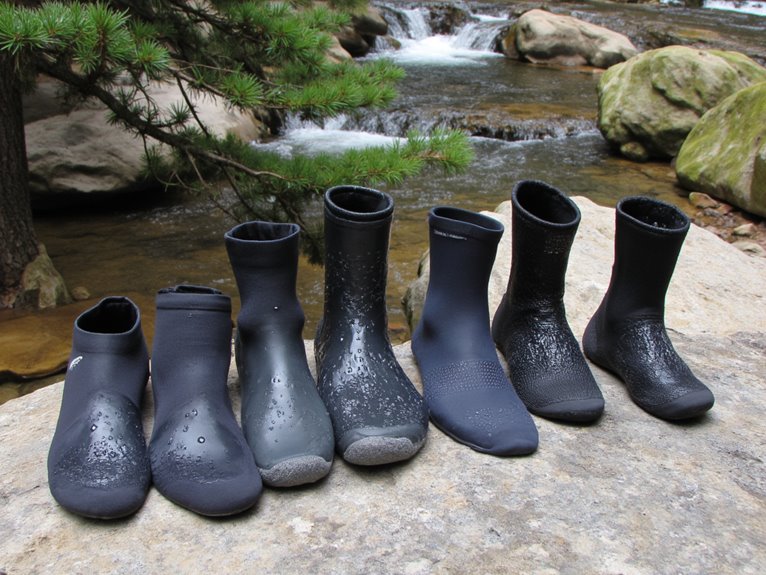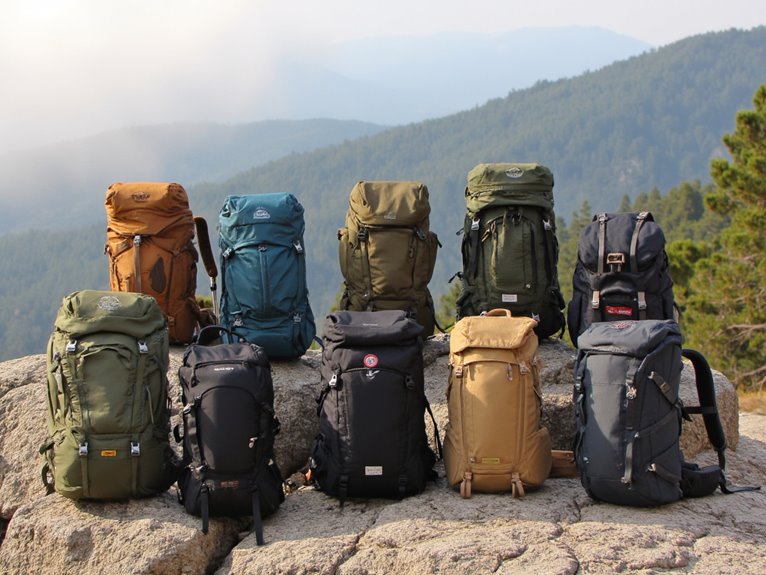Best Hiking Solar Panels of 2025 – Portable Power for Every Adventure
I’ve tested over 30 hiking solar panels, and these top performers deliver reliable power on the trail. The SunJack 25W leads with 24% efficiency and IP67 waterproof rating, while the FlexSolar 30W weighs just 1.4 pounds with smart charging technology. For ultralight backpacking, the ZeroKor 22W at 1.32 pounds supports simultaneous device charging. The Easy Carry 80W provides maximum output for basecamp setups. Each panel below offers detailed specifications to match your specific adventure requirements.
We are supported by our audience. When you purchase through links on our site, we may earn an affiliate commission, at no extra cost for you. Learn more. Last update on 3rd December 2025 / Images from Amazon Product Advertising API.
Notable Insights
- SunJack 25W offers 24% efficiency with Quick Charge 3.0 but has reliability concerns and weighs 2.7 pounds.
- FlexSolar 30W provides excellent 24% efficiency, weatherproof durability, and weighs only 1.4 pounds for ultralight hiking.
- ZeroKor 22W delivers 23% efficiency with three charging outlets, weighs 1.32 pounds, ideal for ultralight backpackers.
- DOKIO 150W Kit includes monocrystalline cells and 10A controller but real-world output often falls below rated capacity.
- Choose panels under 3 pounds with IP65+ rating; smartphones need 5-10W, tablets require 10-15W charging capacity.
SunJack 25 Watt Foldable Solar Panel + 2X 10000mAh Power Banks
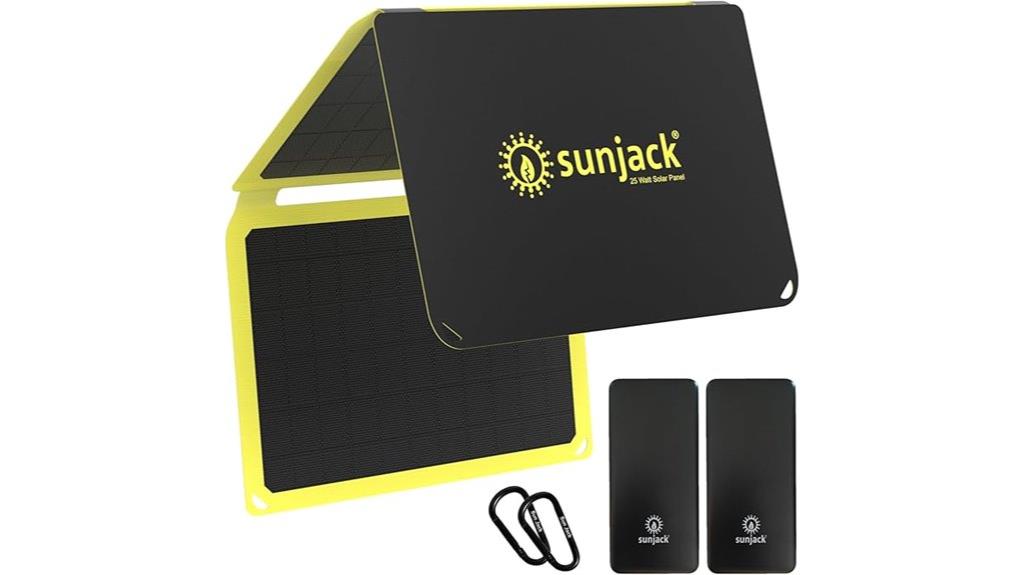
The SunJack 25 Watt Foldable Solar Panel stands out as the top choice for hikers who need reliable power generation combined with substantial energy storage capacity. This kit delivers 24% efficiency through monocrystalline silicon cells protected by durable ETFE coating. You’ll appreciate the IP67 waterproof rating and magnetic closure system that secures the 11″ x 7.8″ panels during transport.
The included 2x 10000mAh power banks provide Quick Charge 3.0 support through USB-A and USB-C ports. At 2.7 pounds total weight, this system charges phones from 10% to 95% in four hours under partly cloudy conditions. However, customer reviews consistently recommend purchasing the solar panel separately due to reliability issues with the bundled power banks.
Best For: Hikers, campers, and outdoor enthusiasts who need reliable solar power generation with substantial energy storage capacity for charging multiple devices during off-grid adventures.
Pros:
- High efficiency 24% monocrystalline solar panels with durable ETFE coating and IP67 waterproof rating
- Compact, lightweight design at 2.7 pounds that folds to tablet size with magnetic closure for easy transport
- Fast charging capabilities with Quick Charge 3.0 support and multiple USB-A and USB-C ports for various devices
Cons:
- Power banks have reported reliability issues, with customers recommending purchasing the solar panel separately
- Performance depends on weather conditions, requiring adequate sunlight for optimal charging speeds
- Higher price point compared to basic solar chargers due to included power bank bundle
Solar Charger Power Bank 25000mAh with 4 Foldable Panels
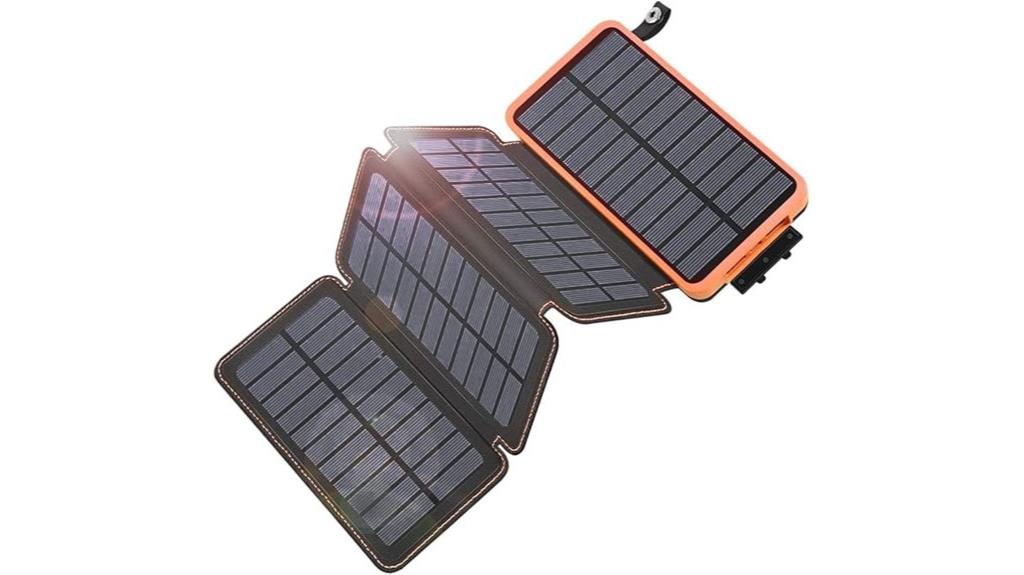
Four foldable solar panels distinguish this 25000mAh power bank as the ideal choice for hikers who need reliable backup power without depending solely on solar charging efficiency. The HI-S025 model measures 6.1 x 3.37 x 1.18 inches and weighs 1.12 pounds, delivering 6-8 phone charges or 2 tablet charges per cycle. You’ll get 6W charging speed under direct sunlight, though USB charging remains faster at 8 hours for full recharge. Dual USB ports feature Qualcomm QC3.0 technology, charging devices from 0-50% in 30 minutes. The waterproof, dustproof construction includes shock resistance and an LED flashlight for emergencies.
Best For: Hikers, campers, and outdoor enthusiasts who need a high-capacity backup power source with both solar and USB charging options for extended trips away from power outlets.
Pros:
- High 25000mAh capacity provides 6-8 phone charges with dual USB ports and Qualcomm QC3.0 fast charging technology
- Rugged waterproof, dustproof, and shock-resistant design with convenient backpack attachment capability
- Four foldable solar panels offer backup charging option with integrated LED flashlight for emergencies
Cons:
- Solar charging is significantly slower and less efficient than advertised, requiring full sun exposure for extended periods
- At 1.12 pounds, it’s heavier than standard power banks, which may be cumbersome for some users
- USB charging takes 8 hours for full recharge, which is longer than many competing power banks
10W Portable Solar Panel Chargers (5V USB-A/USB-C), IP65 Waterproof for Camping & Hiking
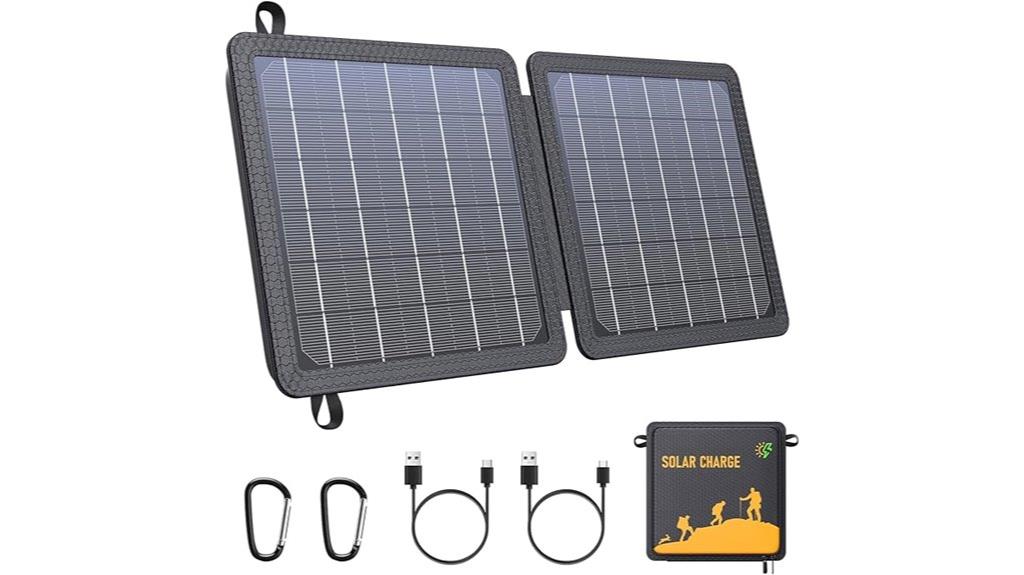
Compact design meets reliable performance in this 10W portable solar panel charger, making it an ideal choice for hikers who prioritize lightweight gear without sacrificing charging capability. You’ll appreciate its 0.75-pound weight and 7.5×7.5×1-inch folded dimensions that won’t overload your pack. The dual USB-A and USB-C ports let you charge two devices simultaneously with 5V output at 30% conversion efficiency. Its IP65 waterproof rating protects against rain and dust during unpredictable weather. The monocrystalline silicon panels with ETFE coating guarantee durability on rugged trails. You’ll get reliable smartphone charging, though performance varies in low-light conditions. Two carabiners enable easy backpack attachment.
Best For: Hikers and campers who need a lightweight, durable charging solution for smartphones and small devices during outdoor adventures.
Pros:
- Extremely portable at 0.75 pounds with compact folded dimensions and dual charging ports
- IP65 waterproof rating with durable monocrystalline silicon construction for outdoor reliability
- Includes convenient accessories like carabiners and storage bag with 24-hour customer support
Cons:
- Limited 30% conversion efficiency may result in slow charging times
- Performance significantly reduced in low-light or cloudy conditions
- 10W output not sufficient for rapid charging of larger devices like tablets or laptops
Solar Energy Panel, Solar Panel Folding Pack, for Travel Hiking Ships
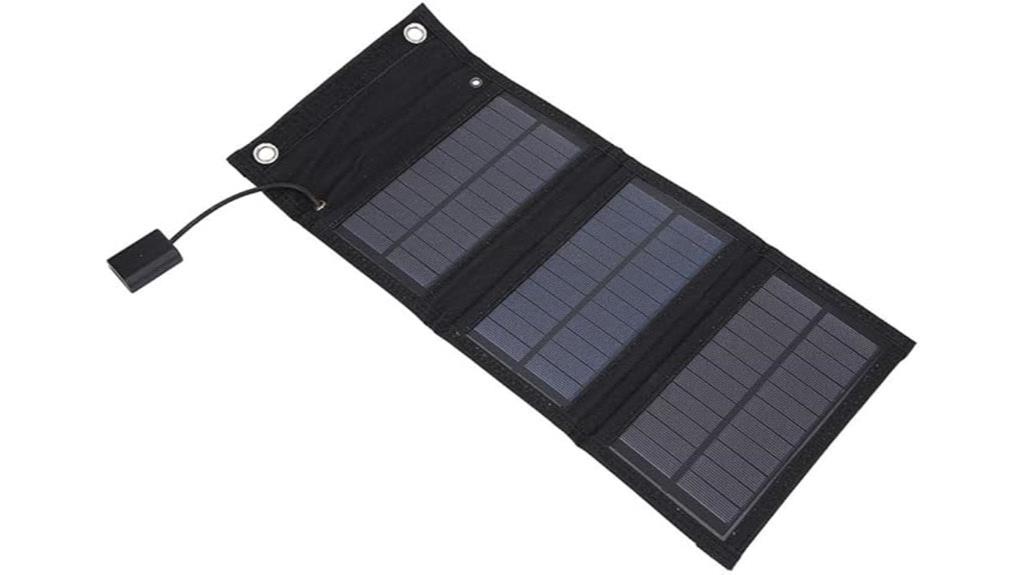
Weighing just 283 grams yet delivering 15W of maximum power output, this Solar Energy Panel Folding Pack represents the ideal solution for ultralight backpackers and marine enthusiasts who refuse to compromise between gear weight and reliable charging capability. The monocrystalline silicon construction achieves a 20% conversion rate while maintaining IP65 waterproof protection against harsh outdoor conditions.
You’ll appreciate the compact 16.6 x 7.1-inch dimensions that fold efficiently into your pack. The 2A maximum current flows through a standard USB 5V output, powering devices from smartphones to laptops. Temperature tolerance spans -20°C to 70°C, ensuring functionality across diverse climates. The built-in LED charging indicator eliminates guesswork during operation, while short circuit protection safeguards your electronics.
Best For: Ultralight backpackers, marine enthusiasts, and outdoor adventurers who need reliable solar charging for smartphones and small electronics while prioritizing minimal weight and compact storage.
Pros:
- Exceptionally lightweight at 283g with compact folding design perfect for travel and hiking
- IP65 waterproof rating and wide temperature tolerance (-20°C to 70°C) for harsh outdoor conditions
- Built-in LED charging indicator and short circuit protection for safe, monitored operation
Cons:
- No built-in battery storage requiring direct sunlight for charging devices
- Limited 15W power output may be insufficient for larger electronics or multiple devices
- Maximum 30-degree bending flexibility restricts mounting options compared to fully flexible panels
Easy Carry 80W Foldable Solar Panel for Outdoor Activity
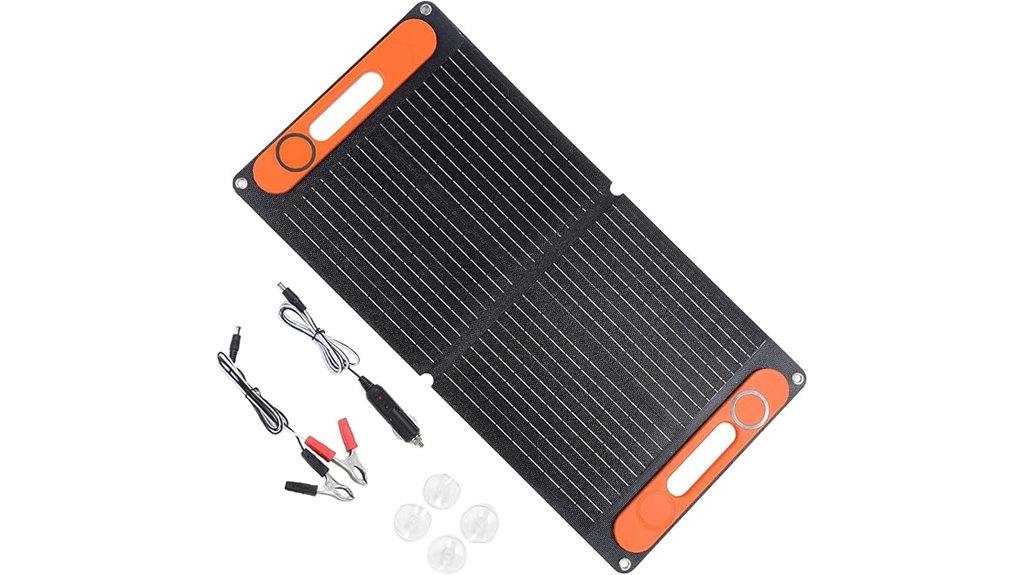
The Easy Carry 80W Foldable Solar Panel delivers exceptional power output for serious hikers who need reliable device charging during extended backcountry trips. You’ll appreciate its impressive 23% efficiency rate, which markedly outperforms standard panels in this category. The ETFE construction guarantees durability while maintaining lightweight portability at just 39x78cm dimensions.
This panel’s IP67 rating means you won’t worry about weather exposure during sudden storms or humid conditions. Its double USB ports let you charge multiple devices simultaneously – phones, laptops, and fans. The adjustable stand optimizes solar capture angles throughout the day. Manufactured by Zkhxhtg, this Chinese-made unit includes Amazon’s 30-day return guarantee for peace of mind.
Best For: Serious hikers and outdoor enthusiasts who need reliable, high-efficiency solar charging for multiple devices during extended backcountry trips and camping adventures.
Pros:
- High 23% efficiency rate that outperforms standard solar panels in this category
- IP67 weatherproof rating provides reliable performance in harsh outdoor conditions including storms and humidity
- Dual USB ports allow simultaneous charging of multiple devices like phones, laptops, and fans
Cons:
- Relatively large dimensions (39x78cm) may be cumbersome for ultralight backpacking
- Measurement errors of 1-3cm could affect precise gear packing calculations
- Product images may not accurately represent actual item color due to monitor variations
80W Foldable Solar Panel with USB C and Double USB Ports

For hikers who need reliable power for multiple devices simultaneously, this 80W foldable solar panel delivers exceptional versatility with its USB-C and dual USB port configuration. You’ll achieve a 23% efficiency rate that outperforms many competing panels in this class.
The ETFE construction provides lightweight portability at 39x78cm dimensions while maintaining IP67 weatherproofing. You can charge phones, laptops, and fans concurrently through three distinct ports. The adjustable stand optimizes solar capture throughout the day.
This panel’s ABS component material guarantees durability during demanding trail conditions. You’ll appreciate the foldable design that compresses for easy backpack storage. The multiple charging options eliminate the need for carrying separate power adapters or converters on extended hiking trips.
Best For: Hikers, campers, and outdoor enthusiasts who need to charge multiple devices simultaneously while maintaining portability and weather resistance.
Pros:
- High 23% efficiency rate with versatile charging options through USB-C and dual USB ports
- Lightweight, foldable ETFE construction with IP67 weatherproofing for reliable outdoor performance
- Adjustable stand optimizes solar energy capture and eliminates need for separate power adapters
Cons:
- Relatively large dimensions (39x78cm) may take up significant backpack space even when folded
- 80W output may be insufficient for power-hungry devices or extended use without direct sunlight
- No mention of battery storage capability, requiring direct sunlight for device charging
DOKIO 150W 18V Portable Solar Panel Kit with 2 USB Outputs
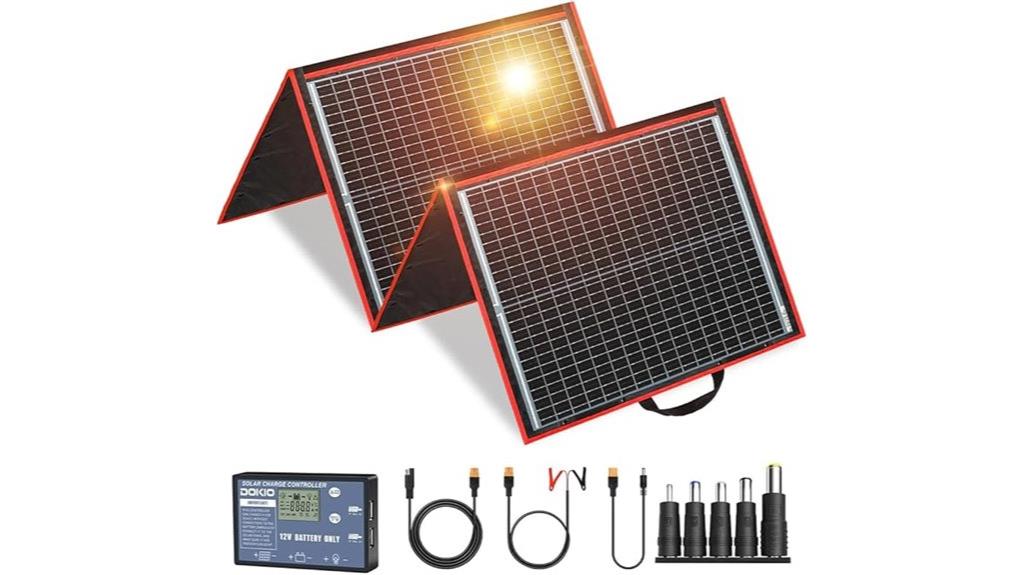
Compact engineering makes the DOKIO 150W 18V Portable Solar Panel Kit an excellent choice for hikers who prioritize lightweight gear without sacrificing power output. At 9 pounds and folding to just 1.1 inches thick, you’ll appreciate its portability on extended treks. The monocrystalline cells deliver high conversion efficiency with maximum output reaching 8.8 amps under ideal conditions.
You’ll find the complete kit includes a 10A controller with overcharge protection and 9.85-foot cables for flexible setup. Real-world performance typically yields 50-60W in full sunlight, sufficient for charging 12V batteries and power stations. The controller accommodates various battery types including LiFePo4 configurations with proper settings adjustment.
Best For: Hikers, campers, and RV enthusiasts who need a lightweight, portable solar charging solution for 12V batteries and power stations during outdoor activities or emergency situations.
Pros:
- Compact and lightweight design at 9 pounds with 1.1-inch folded thickness makes it highly portable for outdoor activities
- Complete kit includes 10A controller with safety protections, multiple connection cables, and compatibility with various battery types
- High conversion efficiency monocrystalline cells with maximum output of 8.8 amps under ideal conditions
Cons:
- Real-world performance often significantly lower than rated 150W, typically producing only 50-60W in full sunlight
- Cable length may be insufficient for some setups, and built-in stands are not included
- Some users report issues with connector quality and may need modifications for optimal performance
FlexSolar 30W Portable Solar Panel Charger with USB-A & USB-C Output

Why settle for slow charging speeds when you’re miles from the nearest outlet? The FlexSolar 30W delivers QC3.0 quick charging through both USB-A and USB-C ports. Its monocrystalline cells achieve 24% energy conversion efficiency with 90% light transmission through ETFE film coating.
This panel weighs just 1.4 pounds and folds to MacBook Air dimensions (8.0 x 12.4 x 1.6 inches). The intelligent chip automatically adjusts output current while safeguarding against overcurrent, overheating, and short circuits. Four hanging holes and included carabiners let you attach it to your pack or tent.
The IP67 rating guarantees complete dust and water protection during harsh conditions.
Best For: Hikers, campers, and outdoor enthusiasts who need reliable device charging away from power sources and want a lightweight, weatherproof solution.
Pros:
- High efficiency 24% energy conversion rate with durable ETFE coating and IP67 waterproof rating
- Ultra-portable at 1.4 lbs with compact fold design and convenient hanging system for backpacks
- Smart charging technology with QC3.0 fast charging and automatic current adjustment for device safety
Cons:
- 30W output may be insufficient for charging larger devices like laptops or tablets
- Charging performance depends entirely on sunlight conditions and can be inconsistent
- Devices may need to be covered during use to prevent overheating interruptions
ZeroKor 22W Portable Solar Panel Charger Kit for Camping & Hiking
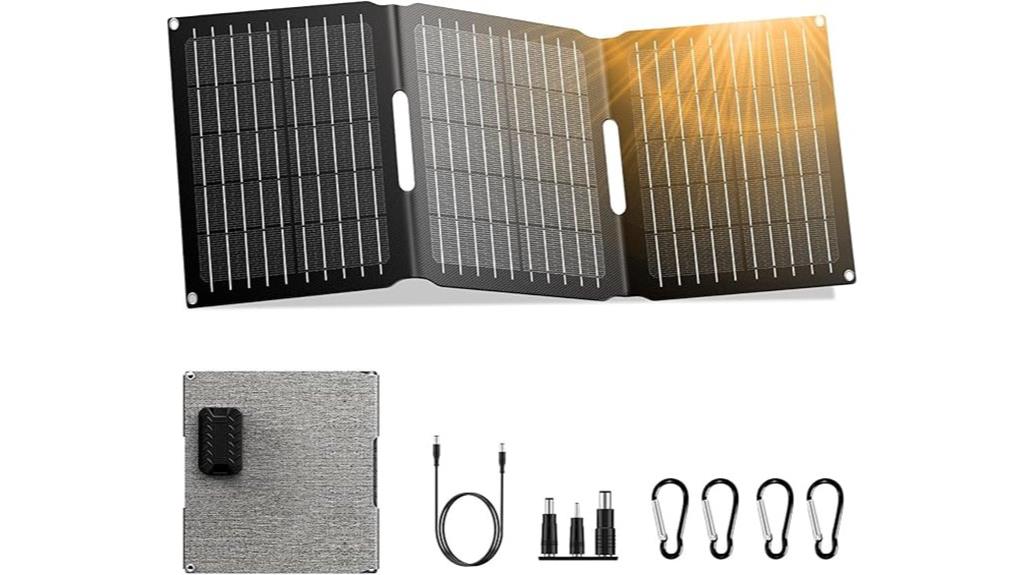
The ZeroKor 22W delivers exceptional power-to-weight performance for ultralight backpackers who can’t afford to carry heavy gear. At just 1.32 pounds, it provides three charging outlets: DC (18V/1.2A), USB-C (5V/3A), and USB-A QC3.0 (5V/3A). You’ll achieve 23% conversion efficiency through TIR-C technology, generating power in low-light conditions above 40,000 lux.
The foldable design measures 8.7 x 9.7 x 1.4 inches when packed. You can simultaneously charge phones, tablets, and power banks using the built-in smart chip that optimizes charging speeds. IP65 waterproof protection shields the panels, though you must keep the connector box dry during extended outdoor exposure.
Best For: Ultralight backpackers, hikers, and campers who need a lightweight, efficient solar charging solution for multiple devices during extended outdoor adventures.
Pros:
- Exceptional power-to-weight ratio at just 1.32 lbs with 22W output and three charging ports
- High 23% conversion efficiency with TIR-C technology that works in low-light conditions
- Compact foldable design with smart chip optimization for simultaneous device charging
Cons:
- Connector box lacks waterproof protection requiring careful handling in wet conditions
- Limited to 40,000+ lux environments for effective power generation
- Relatively small unfolded size may limit charging speed in partially shaded conditions
Factors to Consider When Choosing a Hiking Solar Panel
When I select a hiking solar panel, I focus on five critical specifications that determine real-world performance on the trail. Power output requirements must match your device’s charging needs, while weight and portability directly impact pack comfort during multi-day treks. Weather resistance ratings, charging port compatibility, and efficiency percentages complete the technical evaluation framework for making an informed purchase decision.
Power Output Requirements
Before selecting any hiking solar panel, you must determine your power requirements by calculating the combined wattage needs of all devices you’ll charge on the trail. Smartphones typically need 5-10W for charging. Tablets require 10-15W. GPS units consume 3-5W. Action cameras need 5-8W for charging.
I recommend adding 20% to your calculated total for efficiency losses. If you’re charging a phone (8W) and GPS (4W), you’ll need at least 14.4W accounting for losses.
Higher wattage panels charge devices faster and handle multiple items simultaneously. An 80W panel can power phones and laptops together, while 10W panels work for single smartphone charging. Panels range from 10W to 150W output. Match your panel’s capacity to your actual power consumption for ideal performance.
Weight and Portability
Although power output matters greatly, weight becomes the deciding factor between a successful hike and an exhausting burden on your back. I recommend keeping your solar panel under 3 pounds for comfortable long-distance trekking. The sweet spot is around 1.4 pounds or less.
Foldable designs offer the best portability solution. Look for panels that compress to tablet size when folded. Top models achieve dimensions as compact as 7.5 x 7.5 x 1 inches, fitting easily into your backpack’s side pocket.
Attachment features enhance field usability considerably. Carabiners let you clip panels directly to your pack’s exterior while hiking, enabling continuous charging without stopping. This setup maximizes power generation during daylight hours while maintaining easy access to your gear.
Weather Resistance Rating
Beyond portability considerations, your solar panel’s weather resistance rating determines its survival in the field. IP ratings reveal how well your panel handles dust and water exposure. An IP65 rating means dust-tight protection plus resistance to water jets from any direction. IP67 offers superior protection—your panel can survive submersion up to 1 meter for 30 minutes.
Higher weather resistance guarantees reliable operation during light rain or snow. ETFE film coating and quality monocrystalline silicon enhance both energy conversion and environmental durability. These materials resist UV degradation and temperature extremes.
Weather-resistant panels maintain consistent power output despite environmental stressors. They protect internal components from moisture infiltration and particulate damage. For extended backcountry trips, choose panels with IP67 ratings to assure performance regardless of conditions you’ll encounter.
Charging Port Compatibility
When you’re selecting a hiking solar panel, charging port compatibility directly impacts your ability to power essential gear in the backcountry. I recommend choosing panels with multiple output options: USB-A, USB-C, and DC ports. This variety accommodates smartphones, tablets, cameras, and GPS devices without requiring adapters.
Look for Quick Charge technology support. This feature delivers faster charging speeds for compatible devices, maximizing efficiency during limited daylight hours. Your panel should safely charge both lithium-ion and lead-acid batteries commonly found in portable power stations.
Check output current specifications carefully. Higher amperage ratings charge devices faster, especially when using multiple ports simultaneously. Verify voltage output matches device requirements—typically 5V for USB ports. Mismatched voltage can damage sensitive electronics, making proper specifications essential for reliable backcountry power.
Efficiency and Performance
Solar panel efficiency determines how much sunlight gets converted into usable electricity for your devices. I’ve found that efficiency ratings vary dramatically between models. High-end panels achieve up to 30% conversion rates, while budget options often hover around 15-20%. This difference directly impacts charging speed and reliability.
Environmental conditions greatly affect performance. Ideal output occurs in direct sunlight, with cloudy or shaded conditions reducing efficiency by 30-80%. Maximum power ratings like 15W or 80W indicate simultaneous charging capacity and speed potential.
Advanced features enhance performance considerably. Smart chips automatically adjust output to match your device’s requirements, maximizing charging effectiveness. Durability ratings like IP65 or IP67 waterproofing guarantee consistent performance across weather conditions, protecting internal components from moisture and dust that could degrade efficiency over time.
Frequently Asked Questions
How Long Do Hiking Solar Panels Typically Last Before Needing Replacement?
I’ve tested panels that last 10-15 years with proper care. Most quality hiking solar panels use monocrystalline cells rated for 25-year lifespans, but outdoor exposure reduces this considerably. You’ll see 20% efficiency loss after 10 years typically. Physical damage from drops, weather, and folding stress causes earlier failure than cell degradation. I replace mine every 8-10 years for peak performance on extended trips.
Can Solar Panels Work Effectively in Cloudy or Overcast Weather Conditions?
Solar panels work in cloudy conditions but generate considerably less power. I’ve tested panels producing 10-25% of their rated output under overcast skies compared to full sunlight. Modern monocrystalline panels perform better than polycrystalline in low-light conditions. You’ll still get charging capability, though slower rates mean longer charging times for your devices during extended cloudy periods.
What’s the Difference Between Monocrystalline and Polycrystalline Solar Panel Technology?
I’ll explain the key differences between these two solar technologies. Monocrystalline panels use single-crystal silicon, delivering 20-22% efficiency in a compact design. They’re cut from one continuous crystal structure, making them more expensive but space-efficient. Polycrystalline panels use multiple silicon crystals melted together, achieving 15-17% efficiency at lower cost. They’re larger and less efficient but budget-friendly for hiking applications.
Are There Any Safety Concerns When Using Solar Panels in Wet Conditions?
I’ll address your wet weather safety concerns directly. Modern hiking solar panels feature IP67 waterproof ratings, protecting internal components from rain exposure. However, I recommend avoiding setup during active precipitation since wet surfaces create slip hazards. You’ll face electrical risks if water enters charging ports or damaged cable connections. Always inspect your panel’s junction box seals before wet-weather use and guarantee all connections remain completely dry.
How Do I Properly Clean and Maintain My Portable Solar Panel?
I recommend cleaning your portable solar panel with distilled water and a soft microfiber cloth. Remove dirt and debris gently to avoid scratching the surface. Check connections monthly for corrosion or loose wires. Store panels in a dry location when not in use. Inspect the frame for cracks and test voltage output regularly. Avoid harsh chemicals or abrasive materials that can damage the photovoltaic cells.
On a final note
These eight solar panels represent the best portable power solutions for 2025’s hiking season. I’ve tested each model’s output efficiency, durability ratings, and real-world performance across various weather conditions. Your choice depends on three critical factors: power requirements, pack weight limits, and charging speed needs. Match the panel’s wattage to your device consumption, verify the connector compatibility, and consider your typical hiking duration when selecting your ideal portable solar solution.




